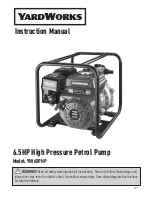
Electrical
8
WIRING CONNECTIONS
NOTICE:
Your pump installation must comply with the National Electrical
Code (NEC) or Canadian Electrical Code (CEC) and with all local codes
that apply.
Step 1. In a new pump, the motor leads will already be connected to the
switch; the motor will be hooked up for 230 volts.
If your power
supply is 115 volts, see Figure 6, Page 7.
Step 2. Connect the ground wire (the green wire) first. Connect it to ground
(see About Grounding, at left) and then to the terminal on the base
or the side of the pressure switch marked GROUND, GRD, or
.
There may be two ground terminals; if so, connect to either one.
See Figure 6 for details.
NOTICE: If you are connecting the motor to a 230 volt circuit using
a four-conductor cable, connect both the neutral (white) and
ground (green) to the ground terminal. The other two wires (two
black wires or one black and one red wire) are the power supply
wires.
Step 3. Connect the power supply wires to the pressure switch terminals
marked LINE, L, or L1/L2. It doesn’t matter which power supply
wire goes to which of these terminals in the pressure switch. In a
new pump, the motor leads will already be connected to the
switch; the motor will be hooked up for 230 volts.
If your power
supply is 115 volts, see Figure 6.
If you are replacing the pressure
switch, connect the motor leads to the switch terminals marked
LOAD, MOTOR, M or M1/M2. Make sure that either:
a. The motor frame is connected to the pressure switch by a solid
metal connection, or
b. The motor ground terminal is connected to the switch ground
terminal by a solid metal conductor at least as large as the
wires carrying power to the motor.
Step 4. Replace the pressure switch cover.
You have just completed the wiring for your pump.
Please go to Page 9 for startup preparations.
About Grounding
Grounding
an electrical device pro-
tects you, the user, from dangerous
electrical shocks and burns by pro-
viding a safe path for the electricity
in cases of current leakage to
ground (due to a short circuit, bro-
ken wire, etc.). The circuit breaker
will sense a rush of current and will
open or ‘trip’, disconnecting the
device and stopping the current
flow.
A circuit breaker which includes a
Ground Fault Circuit Interrupter (a
“GFCI Breaker”)
will protect you
from small current leakages to
ground as well as short circuits. To
avoid nuisance tripping of the GFCI,
consult a licensed electrician about
details of size and type of breaker to
use.
For the best ground connection,
connect the ground wire to a
grounded lead in the service panel
or to a metal underground water
pipe or well casing at least 10 ft.
long. If you use plastic pipe or insu-
lated fittings, run the ground wire
directly to the metal well casing or
use the ground electrode furnished
by the power company.
The ground wire should be of the
same type and size as the wires
used to carry power to the motor.
Never
try to use a gas
supply line as a grounding connec-
tion point.
It could explode.
Never operate this pump unless the
motor is solidly grounded.
If you are not sure about how to
ground the pump and motor, con-
sult a licensed electrician.
DISTANCE IN FEET(METERS) FROM MOTOR TO SUPPLY
0 - 100
101 - 200
201 - 300
301 - 400
401 - 500
Max. Load
Branch Fuse
(0 - 30)
(31 - 61)
(62 - 91)
(92 - 122)
(123 - 152)
Motor HP
Volts
Amp
Rating Amp
AWG WIRE SIZE (mm
2
)
1/2
115/230
9.4/4.7
15/15
14/14 (2/2)
10/14 (5.5/2)
10/14 (5.5/2)
6/14 (14/2)
6/12 (14/3)
Wiring Chart – Recommended Wire and Fuse Sizes






























